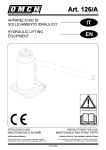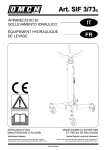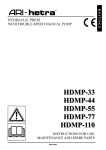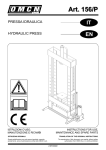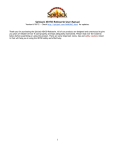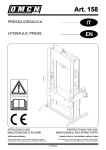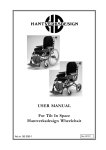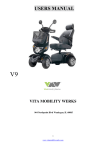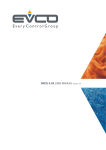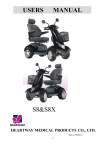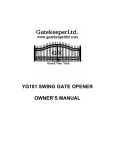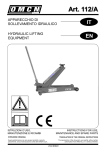Download Art. 156/W Art. P30/W Art. 161/W Art. 162/W Art. 163/W Art
Transcript
Art. 156/W Art. P30/W Art. 161/W Art. 162/W Art. 163/W Art. 164/W INSTRUCTIONS FOR USE, MAINTENANCE AND SPARE PARTS A 01 03 ENGLISH MEDIUM SPEED ELECTROHYDRAULIC PRESSES Before use, place the adhesive labels enclosed with this handbook on the press, as shown in the diagram below. ! WARNING FAILURE IN PLACING THE LABELS WILL LEAD TO THE EXPIRATION OF THE GUARANTEE CONDITIONS AND RELIEVES THE MANUFACTURER OF ANY RESPONSIBILITY FOR DAMAGE RESULTING FROM USE OF THE PRESS. N.B.: If one or more machine labels are damaged, lost or illegible, ask for a replacement by mentioning the relative position number. Place the new label in the point shown in the figure below. 1 2 4 5 OMCN 156/W - 164/W pag. 2 A 01 03 Pay attention to the following hazard signals when reading the manual: ! DANGER ! ! WARNING CAUTION This signal indicates the presence of more or less hazardous conditions or situations. The HAZARD signals are divided into three levels. ! Non respect of this signal causes serious risks for health: death, permanent damages at middle and long term. DANGER ! Non respect of this signal causes serious risks for health: death, permanent damages at middle and long term. WARNING ! Lack of compliance with this signal can cause personal injuries or damage to the machine. CAUTION TERMINOLOGY AND DEFINITIONS (Annex I, directive 98/37/CE) "Operator": the person (s) responsible for installing, starting up, adjusting, servicing, cleaning, repairing and transporting the machine. “Person at risk”: anyone found entirely or partly in a hazardous area. “Area at risk or hazardous”: any area inside and/or near the machine where the presence of a person at risk endangers his/her safety and health. “Specialized technician”: person assigned by the manufacturer to carry out special maintenance operations requiring training and specific skills in mechanics, electrical engineering, electronics, oil hydraulics and pneumatics. The specialized technician is acquainted with all the possible hazards on the machine and the necessary procedures in order to avoid injury to himself or others during these maintenance operations. "User": anyone who purchases or uses the machine (e.g. for renting, leasing or under loan) in accordance with the manufacturer’s instructions. A 01 03 OMCN 156/W - 164/W pag. 3 OMCN 156/W - 164/W pag. 4 A 01 03 User manual TABLE OF CONTENTS: 1.0 INTRODUCTION 2.0 SPECIFIC USE 2.1 Detail of workpiece – Maximum sizes 2.2 MACHINE IDENTIFICATION 2.3 CE CERTIFICATION 3.0 GENERAL SAFETY REGULATIONS 3.1 Safety devices 3.2 Clothing 4.0 TRANSPORT 5.0 UNPACKING 6.0 MAIN TECHNICAL FEATURES 7.0 INSTALLATION AREA 8.0 SPECIFIC USE 9.0 SETTING THE PRESS AT WORK 9.1 Wiring 9.2 Motor rotation check 10.0 USE 10.1 Operation 10.2 Adjustments 11.0 ROUTINE MAINTENANCE 11.1 Changing hydraulic oil 11.2 Cleaning and replacing suction filter 11.3 Cleaning and replacing exhaust filter 11.4 Cleaning exhaust valves 12.0 TROUBLESHOOTING TABLE 13.0 SETTING THE PRESS ASIDE 14.0 SCRAPPING THE PRESS 15.0 FACTORY TESTS 16.0 OIL HYDRAULIC DIAGRAM FOR PRESSES ART. 156/W - P30/W - 161/W 16.1 OIL HYDRAULIC DIAGRAM FOR PRESSES ART. 162/W - 163/W - 164/W 17.0 ELECTRIC DIAGRAM 18.0 ELECTRIC BOX COMPONENTS 19.0 SPARE PARTS ASSEMBLY DIAGRAM 20.0 DIAGRAM OF DISTRIBUTOR’S SPARE PARTS 21.0 DIAGRAM OF HYDRAULIC POWER UNIT SPARE PARTS FOR Art. 156/W - P30/W - 161/W 21.1 DIAGRAM OF HYDRAULIC POWER UNIT SPARE PARTS FOR Art. 162/W - 163/W - 164/W 22.0 EXTRA ACCESSORIES A 01 03 OMCN 156/W - 164/W pag. 5 This handbook contains all the necessary information for safely using, cleaning, lubricating and servicing oil hydraulic presses for maintenance, manufactured by OMCN S.p.A., via Divisione Tridentina, 23 24020 Villa di Serio (Bergamo) ITALY 1.0 INTRODUCTION Carefully read the warnings and instructions found in this handbook as they provide important information on SAFE USE and MAINTENANCE. This manual is an integral part of the product, so keep it in a safe place for the entire product life. If this handbook is lost or damaged, ask for another copy from: OMCN S.p.A., via Divisione Tridentina, 23 24020 Villa di Serio (Bergamo) Italy ! WARNING OMCN S.p.A. CANNOT BE HELD LIABLE FOR ANY DIRECT OR INDIRECT DAMAGE OR INJURY TO PERSONS, ANIMALS OR THINGS CAUSED BY THE FAILURE TO OBSERVE THE INSTRUCTIONS CONTAINED IN THIS HANDBOOK. The press is designed to be used exclusively for maintenance and can therefore be used for servicing and/or making adjustments. The press is not designed to carry out cyclic processing or quantity production and therefore should not be used for bending, drawing or cold forging metals. ! WARNING Uses not explicitly indicated in this handbook are considered improper and therefore strictly forbidden. The manufacturer cannot be held liable for direct or indirect damage or injury to persons, animals or things caused by correct or incorrect use of the press. OMCN 156/W - 164/W pag. 6 A 01 03 2.0 SPECIFIC USE 2.1 Detail of workpiece Maximum sizes The maximum sizes of the workpiece are given in the detailed annex (FIG. 1). The depth of the workpiece is calculated as twice the distance between the centre of the cylinder and rear guard of the press (measurement A FIG. 1); the width is the maximum size allowed by the light between the load-bearing members of the structure (measurement B FIG. 1). REAR GUARD HAZARDOUS AREA OPERATING AREA ! DANGER Avoid heavy strains when loading and unloading the workpieces manually. Any heavy parts (weighing more than 25 KG) must be handled using the appropriate equipment (such as hoisting devices, freight elevators or cranes). Only one operator may carry out work on the press. 2.2 MACHINE IDENTIFICATION Every press has a name plate (POS. 4 Figure PAGE 2) showing the following information: A) B) C) D) E) F) G) H) I) General data, manufacturer’s complete address. Model. Power (thrust force in TONNES). Year of manufacture. Power supply in Volts. Motor capacity in Kw. Operating pressure in bars. Manufacturing lot number. CE mark. A 01 03 OMCN 156/W - 164/W pag. 7 The press has been designed and built according to the provisions in directive 98/37/ CE (machinery directive). Before putting the machine on the market, the manufacturer has compiled the technical file in annex V, ascertaining the machine’s compliance with the fundamental safety and health precautions contained in annex I of directive 98/37/CE. To ensure that the machine conforms with the fundamental safety precautions, the manufacturer has referred to and observed the following regulations: REGULATION YEAR 2.3 CE CERTIFICATION TITLE EN 292-1 1992 MACHINERY SAFETY: Fundamental concepts, general design principles - Terminology, basic methods EN 292-2 1992 MACHINERY SAFETY: Fundamental concepts, general design principals – Specifications and technical principles EN 294 1992 MACHINERY SAFETY: Safe distances preventing access of upper limbs to hazardous areas EN 349 1993 MACHINERY SAFETY: Minimum distances preventing crushing of body parts. EN 414 1993 MACHINERY SAFETY: Design standards and presentation of safety regulations EN 954-1 1996 MACHINERY SAFETY: Category of control systems regarding safety; Part 1: General design principles EN 982 1996 MACHINERY SAFETY: Safety precautions for fluidic systems and components – Oil hydraulics EN 1050 1997 MACHINERY SAFETY: Risk evaluation principles EN 60204-1 1997 MACHINERY SAFETY: Electrical equipment of the machinery; Part 1: general rules EN 60947-5-1 1991 MACHINERY SAFETY: Low voltage electromechanical control circuit switching EN ISO 3746 1995 ACOUSTICS: Sound level measurement of noise sources by sound pressure – Survey method using an enveloping measurement surface over a reflecting plane. EN 50081-2 1993 ELECTROMAGNETIC COMPATIBILITY: General emission regulation; - Part 2: Industrial environment EN 50082-2 1995 ELECTROMAGNETIC COMPATIBILITY: General immunity regulation – Part 2: Industrial environment EN 10025 1995 Hot rolled products of not alloyed steels for structural uses supply conditions. The manufacturer has fulfilled the prescriptions of the above-mentioned provisions and has put the machine on the EU market along with: User handbook CE mark CE compliance statement The manufacturer also has to check the compliance of the machine’s electrical equipment with the requirements of the following European directives: 72/23/CEE (Low voltage). 89/336/CEE (electromagnetic compatibility) OMCN 156/W - 164/W pag. 8 A 01 03 3.0 GENERAL SAFETY REGULATIONS FIG. 1A ! DANGER STRICTLY OBSERVE THE GENERAL SAFETY AND ACCIDENT-PREVENTION REGULATIONS LISTED BELOW: The machine may only be used by responsible staff in good health who have been specially trained to use the press and are acquainted with all the risks. The machine may only be used by operators who have completely read, understood and taken in all the information given in this handbook. It is compulsory to check that there are no persons at risk near the hazardous areas before starting the machine. It is forbidden to remove the guards or tamper with any of the safety devices fitted on the machine. It is compulsory to check that the installed safety devices are in perfect working order before operating the press: it is forbidden to operate the machine if it is faulty. It is compulsory to fit the supporting pins of the work table before operating the press. It is compulsory to check that there are no hazardous conditions for persons at risk during operation. If there are, stop any operations underway immediately and keep people away. It is compulsory to check during the piston movements that there are no objects in area where the piece moved by the cylinder is projected. It is compulsory to switch off the machine by means of the special switch whenever you need to gain access to the hazardous area. Do not leave the machine without turning off the tension acting on the proper switch. When you have finished working with the press, it is compulsory to stop the control unit by operating the special switch to cut off the power supply. It is forbidden to climb or get onto the press (FIG. 1A). It is forbidden to stand near the press bed while the machine is running. Should you notice any unusual sounds or operating faults, It is compulsory to interrupt all operations immediately and find the cause of these irregularities. If in doubt, avoid improper operations and contact the manufacturer’s technical service (OMCN). Any tempering or modification of the machine cause automatically the loss of the guarantee and relieves the manufacturer from all and any responsibilities for direct or indirect damages caused by these tampering. It is compulsory to make sure that the environment where the press is installed is well-ventilated and well-illuminated. The floor on which the machine is to be installed must be solid, flat and perfectly level. During loading, unloading and installation it is compulsory to use lifting and handling equipment with adequate capacity for the weight of the press (See FIG. 3 – TECHNICAL CHARACTERISTICS), using lifting devices and accessories (nylon belts, etc.) that are suitable and in perfect condition for the purpose. We suggest during the maintenance operation to use only original spare parts OMCN. The manufacturer declines any responsibilities for damages caused by the use of non original parts. The use of non original spare parts involves the automatic loss of guarantee. It is compulsory place the press far from heat sources or from devices whom can emit electromagnetic radiations which could cause the bad operation of the devices which are on the electric board. A 01 03 OMCN 156/W - 164/W pag. 9 The press is fitted with following safety devices: Hand-held controls: movements stop immediately as soon as the controls are released. Max. pressure valve protecting the pump: this valve limits the operating pressure to the amount fixed by the manufacturer. Protection device against overcurrents operated by miniature circuit breaker. To operate the press in safe conditions, wear appropriate clothing for the machine and working environment: Do not wear long or flapping clothes, ties, scarves or similar garments that could get caught up in the moving parts of the machine. Keep long hair out of the way and sleeve ends tight; avoid wearing watches, rings, necklaces or other objects that can injure the wearer. Use suitable gloves and protective footwear. If the working environment has a noise level of at least 85 dB (A), wear ear muffs or other hearing protection devices. In every case, refer to the safety precautions regarding working environments of the country where the machine is operated. OM OMCN 156/W - 164/W pag. 10 A 01 03 3.1 Safety devices 3.2 Clothing The machine is supplied already packed in bubble wrap which protects it effectively during transport and handling. 4.0 TRANSPORT The packaged machine must be transported as follows: Always protect the press and electric control unit (1 FIG. 2) against atmospheric agents by covering them with nylon or similar material. Check that the corners on the ends are protected with appropriate materials (bubble wrap/cardboard). Do not use wire rope for lifting purposes. During lifting, sling the press with belts at least 100 cm long with a maximum capacity of over 1500 kg. Check that the bed is fastened securely without play between the bed and structure. Any play could be hazardous. ! USE FORK-LIFT TRUCKS TO MOVE THE MACHINE, GRIPPING AND LIFTING IT AS SHOWN IN FIG. 2. DANGER ! CAUTION FIX THE PRESS SECURELY FOR TRANSPORT IN ORDER TO PREVENT IT FROM SHIFTING ON THE LOADING PLATFORM OF THE VEHICLE OR TRANSPORT EQUIPMENT. FIG. 2 Art. Weight of package Art. 156/W Kg. 190 Art. P30/W Kg. 320 Art. 161/W Kg. 440 Art. 162/W Kg. 480 Art. 163/W Kg. 690 Art. 164/W Kg. 900 A 01 03 OMCN 156/W - 164/W pag. 11 After unpacking, check that the machine and control equipment are perfectly intact and have not been damaged during transport. Notify the manufacturer of any missing parts within 8 days of delivery. If in doubt, do not use the machine and contact the manufacturer. The packing elements are potential sources of hazards and must be kept out of reach of children. Dispose of them in special waste collection areas. The unconnected parts (distributor lever, bed winch crank) must be present. Each of them are fixed with clamps to one of the cylinder pipes and the winch crank arm. For press Art. 156/W, which is without a winch for moving the bed, check the distributor control lever only. The press is supplied with the tank already containing the necessary operating oil. Presses Art. 162/W - 163/W - 164/W work with a dual oil hydraulic pump. This device allows high approaching speed and low speed during operation. The two speeds are switched automatically by a special preset valve. 5.0 UNPACKING 6.0 MAIN TECHNICAL FEATURES Presses Art. 156/W - P30/W - 161/W are equipped with a single pump power unit. The approaching speed is equal to the operating speed. There is a mechanical stop at the end of the cylinder movement. During cylinder return, you can use a working force of approx. 30% of the rating. There are two max. pressure valves: one on the pump for protection, and the other on the distributor for checking the control circuit. The machine has been subjected to noise level tests in a qualified laboratory. The tests were carried out with the machine load less and equipped with its standard components, according to the procedures in regulation EN 3746: 1996. The tests gave the following results: Average acoustic radiation pressure level assessed: LpAm = 70.6 dB (A). Acoustic radiation pressure level in workstation LpAm = 75.8 dB (A). Acoustic power level LwA = 88.1 dB (A). OMCN 156/W - 164/W pag. 12 A 01 03 6.1 SOUND LEVEL The machine needs to be installed in a working area as indicated in the table (FIG. 3). The press must be positioned on a horizontal surface that is preferably 7.0 INSTALLATION AREA From the control point, the operator should be able to see all the equipment and surrounding area, to prevent any unauthorized persons or objects from causing hazards. ! WARNING cemented or tiled. Avoid weak or unsteady surfaces. Any raised floors over empty spaces must have a resistance of 35 N/mm2 equivalent to a class of 350 RBK. The depth of the concrete layer must ensure a tight hold of the anchors and have a sound consistency for at least 200 mm. FIG. 3 Technical specifications and weights refer to the standard and are not binding. Art. Power A B C D E F Piston stroke Capacity of rapid power unit per 1’ Installation area (cm) Motor capacity KW 156/W 20 Ton. 1920 500 1110 510 920 140 285 lt. 2,4 lt. 2,4 600 600 200 120 x 60 1,5 KW P30/W 30 Ton. 2000 600 1600 700 1000 180 260 lt. 4,5 lt. 4,5 575 575 330 170 x 80 3 KW 161/W 40 Ton. 2090 850 1650 775 1135 195 260 lt. 4,5 lt. 4,5 575 575 470 170 x 90 3 KW 162/W 50 Ton. 2080 850 1650 775 1135 205 260 lt. 5 lt. 2,4 600 215 530 170 x 90 1,5 KW 163/W 70 Ton. 2205 900 1755 880 1120 265 310 lt. 6 lt. 4,5 595 280 800 190 x 100 3 KW 164/W 100 Ton. 2280 900 1930 1010 1055 280 310 lt. 10 lt. 4,5 570 180 1050 200 x 100 3 KW A 01 03 Capacity of Speed of Speed of slow Weight slow power rapid stem stem per (kg) unit per 1’ per 1’ (mm) 1’ (mm) OMCN 156/W - 164/W pag. 13 - 8.0 HOW TO USE - INCORRECT - OMCN 156/W - 164/W pag. 14 - CORRECT - A 01 03 - 8.0 HOW TO USE - INCORRECT - - CORRECT - A 01 03 OMCN 156/W - 164/W pag. 15 After unpacking the machine components, check that the machine and all its components are intact. Observe the following instructions in order to set the press at work. A) B) 9.0 SETTING THE PRESS AT WORK Fit the anchors in their holes on the base. Fix the press to the floor, tightening the anchor bolts (FIG. 4). To carry out the operation, observe the following instructions (FIG. 4A): 1) 2) 3) 4) Drill at least 100 mm deep with an 18 ø tip. (1). Clean the hole thoroughly (2). Lightly hammer the anchors into the holes (3). Tighten the bolts with a dynamometric wrench calibrated to 70 N/m (4). Check that the anchors are tight every 1000 working hours. ! WARNING The manufacturer cannot be held liable for any damage caused by the failure to follow the above instructions. Lack of compliance voids the guarantee. FIG. 4A 1 C) D) 2 3 4 Check the oil level in the tank of the oil hydraulic power unit by means of the special oil level indicator on the side of the oil hydraulic power unit. Top up with “AGIP ACER 46” hydraulic oil or equivalent. Assemble the lever on the control distributor, disconnecting it from the hard pipe exiting the distributor. FIG. 4 OMCN 156/W - 164/W pag. 16 A 01 03 9.1 Wiring ! WARNING FIG. 5 BEFORE CARRYING OUT ANY OPERATIONS, CHECK THAT THE PARTS TO BE SERVICED ARE NOT LIVE AND SAFELY DISCONNECTED FROM THE POWER SUPPLY. EVEN THE SIMPLEST ELECTRICAL OPERATIONS REQUIRE RESPONSIBLE AND PROFESSIONALLY QUALIFIED TECHNICIANS. Connect the press to the electrical power supply using the cable exiting the electric control equipment in the following way: Connect the cable to an automatic cutoff device against overcurrents, provided with 30 mA circuit breaker. Check that the power supply voltage is 400 Volts. Check that there is an effective earth wire and that the power supply connections comply with the regulations in force. Should you need to replace the power supply cable, if it is less than 3 m long, use a three-pole + ground cable, at least 4 mm2 in section. Never make any connections on the mains line. In the case of longer cables, the section of the power supply cable must be adapted to the actual length. Wiring must be carried out with the ends of the cable connected to terminals L1, L2, L3 of the electric panel (FIG. 5). The operating voltage is 400 Volts and the connections are provided to withstand this voltage. The press is provided with special devices if you need to use a 230 Volt power supply. To change the wiring, proceed as follows: Check that there is no voltage by pressing the special switch. Remove the cover from the motor’s terminal board. Extract the nuts from the block of contact bars and invert the position of the bars, placing them horizontally (FIG. 7). Retighten the nuts and fit the motor’s terminal board cover back on. Replace the originally fitted circuit breaker with an equivalent one of adequate value. Ask OMCN’s technical assistance department for the necessary circuit breaker. FIG. 6 - 7 400 Volts 230 Volts 400 Volts A 01 03 230 Volts OMCN 156/W - 164/W pag. 17 Turn the main switch to “ON” (1 FIG. 8) to switch on the machine. Pull the distributor level to move the cylinder. The cylinder shaft should start descent. Should it fail to move, invert the motor rotation. First check the motor rotation direction through the tank cap (8 FIG. 10): it should correspond with the arrow next to the cap. To carry out this operation, CUT OFF THE POWER SUPPLY by pressing the special switch and invert two power supply cable phases by inverting a pair of terminals on the electric panel. 9.2 Motor rotation check The press may only be used by authorized, adequately trained, responsible and skilled staff in good health. Pease remember that anybody who uses the press without being acquainted with the procedures specified here could seriously endanger persons at risk and the operator himself. The press has a hand-held control system. Movements stop immediately as soon control is released. 10.0 USE Before using the machine, the operator must have read, understood and taken in the instructions contained in this handbook. ! WARNING THE MANUFACTURER CANNOT BE HELD LIABLE FOR ANY DIRECT OR INDIRECT INJURY OR DAMAGE CAUSED BY THE FAILURE TO OBSERVE THE INSTRUCTIONS CONTAINED IN THIS HANDBOOK. It is compulsory to fit the work table supporting pins before operating the press. ! WARNING BEFORE CARRYING OUT ANY OPERATIONS ON THE MACHINE, MAKE SURE YOU HAVE READ AND UNDERSTOOD ALL THE INSTRUCTIONS IN THIS HANDBOOK. 10.1 Operation FIG. 8 CYLINDER DESCENT: Set the main switch (position 1 FIG. 8) to ON. Pull the distributor lever 3 as far as it will go. CYLINDER ASCENT: Push the distributor lever 3 as far as it will go. Once again, if you release one of the two controls even for an instant, the piston stops moving. The piston stops instantly whenever you release the lever 3. ! DO NOT KEEP ACTIVATING THE PISTON WHEN IT HAS COMPLETED ITS ASCENT AND DESCENT: YOU CAN RISK DAMAGING THE CYLINDER. WARNING OMCN 156/W - 164/W pag. 18 A 01 03 10.2 Adjustments To regulate the operating pressure, turn the handwheel (1 FIG. 9) on the lid of the oil hydraulic power unit. Loosen it to reduce the pressure or screw it to increase it. When you turn the handwheel as far as it will go, you have reached maximum pressure. The work table is moved by operating the winch on the left-hand side of the press. Before moving the work table, pull out the two stop pins on the bed. For press Art. 156/W without a winch, the bed must be moved by hand after pulling out the two stop pins. ! Before carrying out any operations, put the work table pins back in place. Check that both surfaces of the bed are resting on the pins. WARNING FIG. 9 MOTOR TERMINAL BOARD (1) MAX. VALVE LOADING PLUG WITH LEVEL (INDICATOR) PLUG FOR CHECKING MOTOR ROTATION DRAIN PLUG For presses: Art. 156/W Art. P30/W Art. 161/W Electric terminal block For presses: Art. 162/W Art. 163/W Art. 164/W A 01 03 OMCN 156/W - 164/W pag. 19 Routine maintenance includes cleaning, lubricating, greasing and adjustments that need to be carried out at regular fixed intervals in order to ensure that the machine operates correctly and the safety devices are in perfect working order. All those operations not mentioned below are considered extraordinary operations, which may only be carried out by the manufacturer. ! WARNING 11.0 ROUTINE MAINTENANCE THE OPERATIONS DESCRIBED BELOW MUST BE CARRIED OUT BY TECHNICAL STAFF SPECIALIZED IN MECHANICS, ELECTRIC ENGINEERING AND OIL HYDRAULICS. To ensure that the press operates correctly and efficiently, follow the instructions below and perform all the cleaning and routine maintenance operations according to the frequencies described below. ! WARNING CLEANING AND ROUTINE MAINTENANCE MAY ONLY BE CARRIED OUT IN SAFE CONDITIONS. FOR THIS PURPOSE, SET THE MAIN SWITCH TO OFF BEFORE STARTING ANY CLEANING OR MAINTENANCE. EVERY DAY: Before starting up the machine, check its overall state by making sure that the piping is intact and without hydraulic oil leaks. EVERY 1000 HOURS: Replace the oil in the power unit using hydraulic oil “AGIP ACER 46” or equivalent in the fixed quantities indicated (See FIG. 9A). Clean the pressure regulating valves according to the instructions given below. Clean the suction filter according to the instructions given below. Check that the anchors fastening the press to the floor are tightened securely. EVERY 2000 HOURS: Replace the suction filter and clean the exhaust filter cartridge on the power unit lid, following the instructions given below. EVERY 4000 HOURS: Replace the exhaust filter cartridge inside the exhaust filter cover, which is located on the power unit. Follow the instructions given below. Check the machine’s overall state of repair, making sure that there are no visible signs of buckling and/or cracks on the welding. Check that the oil hydraulic system components, piping, flexible tubes and unions are intact. Check the general condition of the electric system components: cable glands, electric control unit and power supply cable. Replace any of these components if they are not perfectly intact or functional. OMCN 156/W - 164/W pag. 20 A 01 03 FIG. 9A Art. Oil quantity Art. 156/W lt. 24 Art. P30/W lt. 24 Art. 161/W lt. 50 Art. 162/W lt. 50 Art. 163/W lt. 80 Art. 164/W lt. 90 11.1 CHANGING HYDRAULIC OIL Change the oil as follows: 11.2 CLEANING AND REPLACING THE SUCTION FILTER Replace the suction filter as follows: 11.3 CLEANING AND REPLACING THE EXHAUST FILTER Clean or replace the exhaust filter as follows: 11.4 CLEANING THE REGULATING VALVES Clean the regulating valves as follows: Unscrew the cap on the back of the tank. Empty the tank completely. Screw the cap back on the tank. Fill up the tank through the cap (4 FIG. 10) on the top of the tank. The quantity of oil to be put in the tank depends on the type of power unit (see FIG. 9A) for the quantities. Disconnect the two flexible tubes from the valve stop on the lid of the oil hydraulic power unit. Lift the lid with the pump unit and disconnect the filter, undoing the screws. Clean the cartridge with compressed air or replace it with a new filtering cartridge. Fasten the filter with its screws. Put the lid and pump unit back in place. Reconnect the two flexible tubes of the valve stop. Take off the filter cover by loosening the screws. Pull out the filter cartridge. Clean with compressed air or replace it with a new filtering cartridge. Put the cover back on, securing it with the screws supplied. Pull the valve out of its housing (1 FIG. 10). Clean with compressed air and petrol, handling it with care to avoid damaging it during assembly and dismantling. FIG. 10 5 2 1 9 4 7 For presses: Art. 156/W Art. P30/W Art. 161/W ! For presses: Art. 162/W Art. 163/W Art. 164/W Any extraordinary maintenance and repairs must be carried out by the manufacturer. WARNING A 01 03 OMCN 156/W - 164/W pag. 21 12.0 - TROUBLESHOOTING TABLE PROBLEM POSSIBLE CAUSES SOLUTIONS The pumps are on but the cylinder does not move. 1 The motor rotates in the opposite 1 Change the motor rotation by direction. inverting two power supply cable 2 Primary pump cut off valve is faulty. phases. 2 Check the cut off valve spring and 3 Primary pump cut off valve is eliminate the causes of malfunction. broken. 3 Replace the valve spring. With the cylinder resting on the workpiece, the pressure does not rise smoothly. 1 There is air in the circuit. With the cylinder resting on the workpiece, the pressure does not reach the preset value. 1 No oil in the tank. 2 Suction filter is clogged up 2 Oil leak in the circuit. 3 Max. pressure valve is clogged up. 4 Max. pressure valve is broken. 5 One or more pump units are worn. 6 Cylinder gasket is damaged. 7 Cylinder liner is worn or damaged. 1 Lift and lower the cylinder stem as far as it will go. 2 Lift the lid off the oil hydraulic power unit (as described in the maintenance chapter) and clean or replace the filter. 1 Check the oil level by looking at the dipstick on the tank cap. Top up if necessary. 2 Check that the pipe fittings and distributor are not leaking oil. Check that the pipe fittings are securely tightened and replace them if necessary. 3 Remove the max. pressure valve, clean it with petrol and compressed air and check the state of the spring. 4 Replace the max. pressure valve. 5 Replace the damaged pump units (contact the OMCN technical service). 6 Replace the damaged gasket (contact the OMCN technical service). 7 Replace the cylinder. With the cylinder resting on the piece, the pressure decreases too much when the controls are released. 1 The distributor housings or slider are 1 Pull the slider out of the distributor dirty. housing and clean the slider and its housing. If the slider is damaged, replace the entire distributor (Chap. 21 FIG. 14). 2 Cylinder gasket is damaged. 2 Replace the damaged gasket (contact the OMCN technical service) or replace the cylinder. 3 Cylinder liner is damaged. 3 Replace the cylinder. On operating the controls, the pump does not start. 1 Thermal protection has tripped. 2 Missing phase on the power supply line. 1 Reset the circuit breaker. 2 Check the continuity of the 3 phases on the power supply cable. Replace the cable if necessary. If the problems persist, contact the manufacturer and avoid unspecific operations. Contact the authorised centres for assistance and ask for original parts. The list of spare parts is enclosed with this instruction handbook. OMCN 156/W - 164/W pag. 22 A 01 03 13.0 SETTING THE PRESS ASIDE If the machine is set aside for long periods, disconnect all supply sources, drain the tank of hydraulic oil and protect any parts that risk damage due to dust or atmospheric agents. The flexible tubes and components that risk damage due to drying out must be adequately greased. When setting the press at work after a long time, check that the flexible tubes are perfectly intact without cuts, scratches or cracks. 14.0 SCRAPPING THE PRESS At the end of the machine’s life cycle or when you decide not to use it any more, make it inoperative by removing all the hydraulic oil left in the tank and in the drive cylinder. The press must be disposed of as special waste, so dismantle it into homogeneous parts and dispose of them in compliance with the regulations in force. 15.0 FACTORY TESTS Before packing, the press was subjected to operating tests regarding the parts listed below: Ascent - descent piston speed check. Bed and cylinder table parallelism check. Work table movement check. Max. pressure valve check and calibration. Check for no leaks or seepage from the pipe fittings. A 01 03 OMCN 156/W - 164/W pag. 23 16.0 OIL HYDRAULIC DIAGRAM FOR PRESSES: ART. 156/W ART. P30/W ART. 161/W FIG. 11 Suction filter Pump Oil tank Max. valve 400 BAR (500 BAR for Art. 156/W) F Manual distributor H Cylinder I Pressure gauge M Electric motor A C D E OMCN 156/W - 164/W pag. 24 A 01 03 16.1 OIL HYDRAULIC DIAGRAM FOR PRESSES: ART. 162/W ART. 163/W ART. 164/W FIG. 11/A A B C D E F H I M Suction filter 20 BAR cut off valve Double pump Oil tank 400 BAR max. valve Manual distributor Cylinder Gauge Electric motor A 01 03 OMCN 156/W - 164/W pag. 25 17.0 ELECTRIC DIAGRAM FIG. 12 (*) Thermal calibration Art. 156/W = Art. P30/W = Art. 161/W = Art. 162/W = Art. 163/W = Art. 164/W = SM1 M 4 Amp 6,9 Amp 6,9 Amp 4 Amp 6,9 Amp 6,9 Amp Thermal switch Electric motor 18.0 ELECTRIC BOX COMPONENTS FIG. 13 SM1 SM1 CONTACTOR SWITCH OMCN 156/W - 164/W pag. 26 A 01 03 OIL HYDRAULIC UNIT FOR PRESSES: ART. 156/W ART. P30/W ART. 161/W OIL HYDRAULIC UNIT FOR PRESSES: ART. 162/W ART. 163/W ART. 164/W 19.0 SPARE PARTS ASSEMBLY DIAGRAM FIG. 14 A 01 03 OMCN 156/W - 164/W pag. 27 List of components 1 2 3 4 5 6 7 8 9 10 11 12 13 14 15 16 17 18 19 20 21 22 o 23 o 24 o 25 o 26 o 27 o 28 Frame Shelf plane for pump Foot Screw Washer Nut Cylinder Screw Washer Nut OR gasket DAS gasket Stem Spacer OR gasket Anti-extr. ring for OR Guide flange Guide ring RS gasket Guide ring Dust scraper Protection cup Winch Screws Pin Pulleys Pulleys Pulleys LIST OF COMPONENTS OF OIL HYDRAULIC UNIT FOR PRESSES: ART. 156/W -ART. P30/W ART. 161/W 30 31 32 33 35 36 37 39 40 41 Motor pump unit Pressure valve Pressure gauge Oil level cap Oil plug Electric terminal board Drain plug Gas ring Nut Return pipe OMCN 156/W - 164/W pag. 28 o 29 42 43 44 45 46 47 48 49 50 51 52 53 54 55 56 57 58 59 60 61 62 63 64 o 65 o 66 67 Metal rope Copper gasket Diverter group Copper gasket Straight union Gas ring Nut Lowering pipe Lifting pipe Copper gasket Union below Gas ring Nut Main switch Screws Screw Washer Nut Work cross piece Work cross piece Lockpin Spacer pins Washer M16 screw Crank Handgrip Pressure pipe LIST OF COMPONENTS OF OIL HYDRAULIC UNIT FOR PRESSES: ART. 162/W - ART. 163/W ART. 164/W 30 31 32 33 34 35 36 37 38 39 40 41 70 Motor pump unit Pressure control valve Gauge Air filter Oil filter Oil cap Electric terminal block Copper gasket Union elbow Sealing ring Nut Return pipe Oil level cap A 01 03 (o) Parts not included in Art. 156/W 20.0 DIAGRAM OF DISTRIBUTOR’S SPARE PARTS FIG. 15 1 2 3 4 5 6 7 8 9 10 11 12 13 14 Central body OR gasket Spacer ring Scraper ring Stem Spacer Spring Spacer Ball housing Shim Cap Body Mushroom comp. valve Copper washer Spring Piston ring OR gasket Cap Aluminium washer A 01 03 15 16 17 18 19 20 21 22 24 26 27 28 29 30 31 32 33 34 36 Regulator Max. valve box nut Maximum valve Washer Lever Pin Box lid body Support Lever rod Screw Cap Washer Washer Steel ball Cap Cap Washer Cap Washer OMCN 156/W - 164/W pag. 29 21.0 DIAGRAM OF HYDRAULIC POWER UNIT SPARE PARTS FOR Art. 156/W - P30/W - 161/W FIG. 16 1 2 3 4 5 6 7 8 9 10 11 12 13 14 15 16 17 18 19 20 Tank Tank cover Self-locking nut Motor nut Motor tie rods Stator casing Oil level lamp Rotor Motor tree Front bearing Front motor flange Ring OR Pumping body Perforated screw Piston Drain plug Washer OR-cord Washer OMCN 156/W - 164/W pag. 30 21 22 23 24 25 26 27 28 29 30 31 32 33 34 35 36 37 38 39 40 Terminal board box Cable clamp Terminal board Term. board fixing screws Rear motor flange Box fixing screws Bleeding cap Spring washer Rear bearing Tank cover Washer Motor support bracket "P" flange Pressure gauge Wheel counter nut Max. valve wheel Counter nut Max. valve "T" flange Drain pipe A 01 03 41 42 43 44 45 46 47 48 49 50 51 52 53 54 55 56 57 58 59 Pump cap Spring Spring guide Washer Pump fixing screws Spring Spacer Spacer Snap ring Cam Pin Spacer Spacer Pump bearing Snap ring Spring guide Suction filter Delivery union Delivery pipe 21.1 DIAGRAM OF HYDRAULIC POWER UNIT SPARE PARTS OF Art. 162/W - 163/W - 164/W FIG. 17 Pumping unit 1 2 3 4 5 6 7 8 9 10 11 12 13 14 15 16 17 18 19 20 Lid screws Tank lid Tank Washer Self-locking nut Screw Washer Oil level light Mot pos. flange Rear bearing Spring washer Stator housing Motor rotor Motor shaft Mot. supp. bracket Motor tie rods Front mot. flange Front bearing Pump unit Blade 21 22 23 24 25 26 27 28 29 30 31 32 33 34 35 36 37 38 39 40 Pump rotor Drain plug Washer OR braid Cable clamp Terminal block Terminal board Terminal board screw Terminal block screw Bleed plug Air bleed filter Return tube Inspection lid Exhaust filter Washer Washer Nut Filter screw Stator ring Screw A 01 03 41 42 43 44 45 46 47 48 49 50 51 52 53 54 55 56 57 58 59 60 Tab Washer Pump screw Suction filter OR ring Drilled screw Pump washer Spring guide Spring Ring Pumping body Piston Spring guide Pumping element bearing Spacer Eccentric Spacer Spacer Spring Needle bearing OMCN 156/W - 164/W pag. 31 In order to get better the operations of the machine, and in the meantime to give more safety and functionality to the use of the machine, OMCN supply extra equipments suitable to the different models presented in the manual. The different equipments suitable for every model of machine are reported on the OMCN general catalogue. The specific instructions for the safety use of the equipment are supply with the equipment itself and are not reporter in this manual. OMCN 156/W - 164/W pag. 32 A 01 03 22.0 EXTRA EQUIPMENTS NOTES: A 01 03 OMCN 156/W - 164/W pag. 33 24020 VILLA DI SERIO (BG) ITALIA Via Divisione Tridentina, 23 Tel: 035/423.44.11 r.a. -Fax (Italy) 035/423.44.41 - 035/423.44.42 - Fax Export: +39/035/423.44.49 OMCN/INTERNET: http:// www.omcn.com http:// www.omcn.it e-mail: [email protected] e-mail: [email protected] Dealer's stamp: A 01 03




































